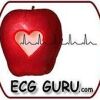This ECG was obtained from an elderly man with a history of congestive heart failure. He is hypertensive at 180/102, and short of breath with bibasilar rales.
We can see on this 12-Lead ECG that all the criteria for left bundle branch block have been met.
ECG criteria for left bundle branch block
- Wide QRS > 120 ms
- Supraventricular rhythm
- Negative QRS is V1 — rS or QS pattern
- Positive QRS in V6 and Lead I (lateral leads) – may be wide and monophasic, have a notch or “M” shape, or Rs pattern.
Here we see a QRS complex that is 140 ms (0.14 seconds) wide. The rhythm is sinus tachycardia at 110/minute, and the QRS in V1 is negative (rS), while the QRS complexes in V6 and Lead I are positive. The criteria are met.
Some other features of left bundle branch block
- Discordance of ST and T waves. They should be opposite the direction of the QRS. In fact, if they are not discordant, it is considered an abnormality. There will be ST depression in leads with positive QRS complexes and ST elevation in leads with negative QRS complexes. (Compare V1 and V6 in the ECG).
- Left axis deviation is common in LBBB. Leads I and aVL will have a taller QRS than Lead II. Lead II may be flat or negative, and Lead III will be negative.
- Poor R wave progression in the chest leads. There will be an abrupt change from negative QRS complexes to positive. (Look at V4 and V5 in the ECG).
What is happening in left bundle branch block?
The bundle branch system in the left ventricle is not functioning, either permanently, temporarily or even intermittently. LBBB can even be rate-related, occurring during fast rates or in premature beats. The septum is depolarized from right to left (which is opposite of normal), and the right ventricle is depolarized quickly.
The wave of depolarization then travels from the right ventricle to and across the left ventricle. This cell-to-cell depolarization is much slower than conduction that proceeds by way of the bundle branches. It causes a loss of synchronization between the right ventricle, septum and left ventricle.
More than one problem
To make things worse, on this ECG the voltage criteria for left ventricular hypertrophy are met. There are extremely deep S waves in the right chest leads, V1 — V3. It’s very common for LBBB and LVH to appear together in the same patient. In fact, LVH will be present in upwards of 80 percent of people with LBBB. Both are caused by similar conditions, such as hypertension, diabetes, coronary artery disease, myocardial infarction, and valve disease. Left ventricular hypertrophy is best diagnosed by echocardiography, not ECG, but the large S waves are enough on this ECG to convince me that LVH is present.
LVH and LBBB cause similar ECG changes. Like LBBB, LVH also causes discordant ST-T waves. The ST segments in leads with upright QRS complexes have a sloping depression, called the strain pattern. In leads with negative QRS complexes, like V1 and V2, we will see a reciprocal view of this pattern: ST elevation. LVH can also widen the QRS and shift the axis to the left.
So, why don’t we like left bundle branch block?
- LBBB is almost always accompanied by significant heart disease (Unlike RBBB).
- The wide QRS complexes are associated with a much lower cardiac output (15 percent or more), and much less efficient cardiac function.
- LBBB can mimic ventricular tachycardia when the fast rate obscures P waves.
- The ST and T wave changes of LBBB (and LVH) can mimic acute MI.
- The ST and T wave changes of LBBB (and LVH) can hide acute MI.
- New-onset LBBB during an acute MI has been shown to greatly increase mortality and morbidity.
What does this mean for EMS treatment of the patient in this ECG?
Use your heart failure protocols and remember that he has poor left ventricular function. He will not tolerate a fluid overload, lying down flat, or exercise. Don’t be fooled by the ST elevations and depressions. In a wide QRS setting, discordant ST elevations and depressions are normal. It is when they are concordant that they may be significant.
This patient met the hospital criteria to receive a bi-ventricular pacemaker, which resynchronizes the ventricles and greatly improves cardiac function.
What are your thoughts or questions about this patient’s 12-Lead ECG?













